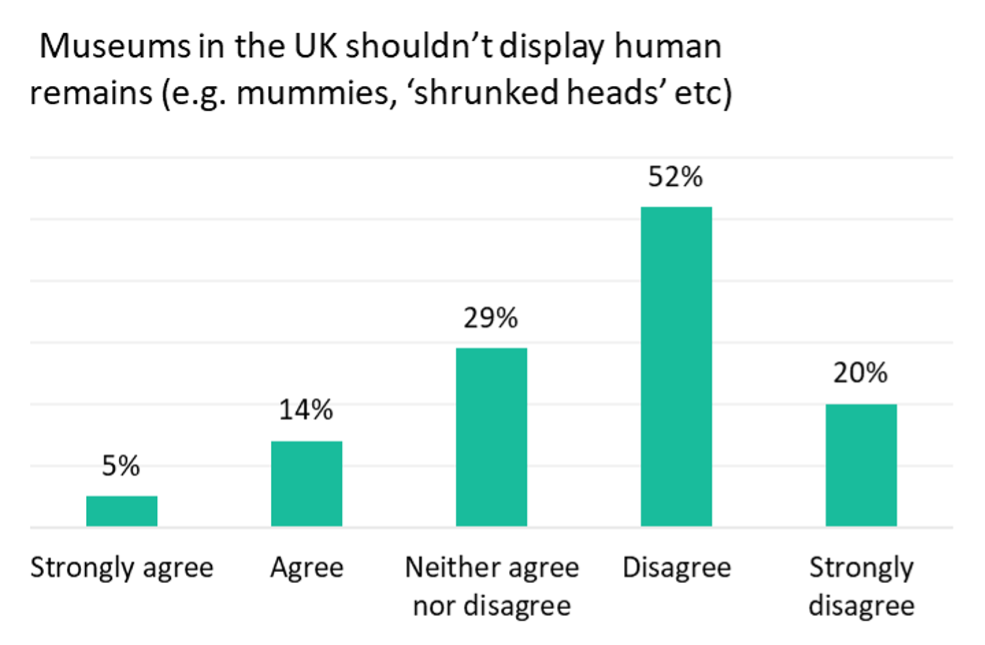Opinions on the display of human remains in museums
August 2025
This research is from The Audience Agency's nationwide longitudinal (ongoing) panel survey of changing views about participating in creative and cultural activities through the recent and ongoing crises, and beyond, the Cultural Participation Monitor.
Themes
- Cultural Participation
-
Museums & archives
Debate about the display of human remains has been in the news recently, here's what our research found.
We recently noticed this article about Manchester Museum asking visitors whether it should continue to display the body of an ancient Egyptian woman.
This reminded us of a related question we asked in the Cultural Participation Monitor (in March 2024): To what extent do you agree or disagree with the following statement: ‘Museums in the UK shouldn’t display human remains (e.g. mummies, ‘shrunked heads’ etc)’.
Here’s what members of the public said:

Most disagreed (72%), with only 19% agreeing.
Some groups, however, were more likely to agree than overall: 34% of 25-34 year olds, 32% from Asian/Asian British backgrounds, 48% from Black/Black British backgrounds*, 27% of those with children and 23% of Senior Managers for example. 25% of those with an interest in history and heritage also agreed.
It’s likely that presentation of the question at Manchester Museum within the exhibition will result in a more positive response. It’s being asked about a specified, named, individual (Asru), rather than as an abstract principle, and alongside discussion of decolonisation of museum collections. Manchester Museum also has a notable track record of recognising their obligations to communities whose collections they hold (for example return of cultural heritage to the Anindilyakwa People). This might also make visitors more likely to agree.
What the response to the question in the Cultural Participation Monitor does suggest, however, is that Manchester Museum can be seen to be leading, rather than following, public opinion by posing the question. We’ll be interested to see what the public say in this instance, but also how attitudes continue to evolve.
*The sample isn’t quite big enough to identify this as a statistically significant difference between Asian/Asian British and Black/Black British respondents, although both are significantly different from White respondents.
Related videos
Cultural Participation Monitor | Latest Findings on Audience Attitude and Behaviours
Watch nowTEA Break: Bad behaviour? - What types of behaviour people prefer when attending culture
Watch nowTEA Break | From Interest into Action
Watch nowTEA Break | More Insights on Changing Audiences
Watch nowTEA Break | Key Changing Audiences for Art Forms
Watch nowOther findings from Wave 10 | Mar 2024 | Places. event timings, heritage, social & digital
-
Use of social and digital by Audience Spectrum
Use of digital media and digital varies between Audience Spectrum, suggesting different potential routes to reach different segments.
-
Interest in history and heritage
Heritage is broadly popular with the general population, with high proportions saying that it’s an interest of theirs.
-
Attitudes to heritage
We asked the extent to which people agreed or disagreed with a range of statements about history and heritage, to better understand the attitudes which people bring to their engagement. These results were surprising in a number of ways: neither consistently conforming to a traditional nor a progressive perspective.
Other findings about Museums & archives
-
Interest in history and heritage
June 2024
-
Attitudes to heritage
June 2024
-
Museums Audience Report
November 2018
